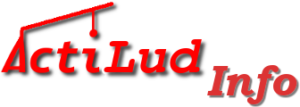The Actilud site offers a range of configurable exercises for working on basic additive problems.
The problems are classified according to Vergnaud’s typology – they are not sorted by the type of operation they involve – addition or subtraction – but by their nature. The same type of problem can therefore be solved by either operation. Hence the importance of carefully analyzing the statement…
State composition

Two states, A and B, are combined to form a new state, C. States A and B remain unchanged.
Alice has 3 marbles. Bob has 5. How many marbles do they have together?
Alice and Bob have 10 marbles in total. Alice has 4. How many marbles does Bob have?
State transformation

State A is transformed into state B by a transformation t.
Alice has 3 marbles. She wins 5 against Bob. How many does she have at the end of the game?
Alice has won 5 marbles against Bob. At the end she has 8. How many did she have at the beginning?
State comparison

Two states A and B are compared by operation c. The two states are not modified. Comparison problems can be identified by the frequent use of the words “more”, “less”…
Alice has 8 marbles and Bob has 5. How many more marbles does Alice have?
Alice has 8 marbles and Bob has 3 less. How many marbles does Bob have?
Composition of transformations

This is undoubtedly the most difficult type of additive problem. We don’t know the states on which the transformations operate. A t1 transformation is composed with t2, giving t3.
Alice plays against Bob. She wins 5 marbles and then loses 6. At the end of the game, how many has she lost in total?
Alice plays Bob twice. In the first round, she wins 5 marbles. At the end of the game, she has lost a total of 1 marble. How many marbles did she lose in the second round?
Use of the Actilud website
Actilud offers several exercises for each type of problem: with marbles, scales, liquids, or decimal dominoes. The difficulty varies depending on the object used and the skills it requires—for example, it’s better to know how to weigh if you choose the Roberval scale.
Should students be taught Vergnaud’s typology?
To answer this question, we must first ask ourselves what our objective is. If, presumably, it is to enable students to solve statements, the question to ask is: is the ability to classify statements necessary to be able to solve them?
The answer, in my opinion, which is entirely my own, is no. As you can see from the site, there are various problem-solving methods (marbles, rulers, etc.). One of them, the bar diagram, applies to all additive problem situations, whatever their type. As a result, there’s no need to teach students Vergnaud’s typology, since these tools work in the same way in all cases. The typology is a useful tool for teachers, enabling them to assess the difficulty of teaching problem-solving according to type. But let’s leave it to the teachers.
When creating a problem bank, you can divide the different statements into pockets of different colors, or with different logos. When students select a problem from a pocket, they are asked to put it back in its place when they have finished. But they are not asked to classify the statements by themselves. That’s the teacher’s job. If you’re using the website, you can add – in addition to the color and logo – the letters C, D, E, F, which correspond to the different typology entries on the site; this is quite sufficient and helps students understand the link between the exercises proposed online and those in the folder.
Should we do everything?
Not unless your class is particularly high-performance!
The minimum objective
- compositions
- find the whole
- find a part
- transformations
- find the final state
- find the transformation
With this, students will already be well equipped. If they’ve already had a hard time assimilating, leave it at that for now.
Remember that it’s best to avoid focusing on one type of problem for too long. Often, changing the type of problem makes it easier to understand! We sometimes see “flashes” of understanding – the student exclaims, suddenly he’s understood.
The standard objective
This is the minimum objective to which we add:
- comparisons
- find the result
- find the comparison
Go further
We’ve included all the Vergnaud types for those who want a more comprehensive approach. But be careful not to overcomplicate the learning process.
To find out more…
Visit Actilud to watch our videos (only in French for instance).
